Fetal position reflects the orientation of the fetal head or butt within the birth canal.
Anterior Fontanel
The bones of the fetal scalp are soft and meet at “suture lines.”
Over the forehead, where the bones meet, is a gap, called the “anterior fontanel,” or “soft spot.” This will close as the baby grows during the 1st year of life, but at birth, it is open.
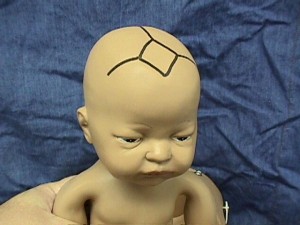
The anterior fontanel is an obstetrical landmark because of its’ distinctive diamond shape. Feeling this fontanel on pelvic exam tells you that the forehead is just beneath your fingers.
Early in labor, it is usually difficult (if not impossible) to feel the anterior fontanel. After the patient is nearly completely dilated, it becomes easier to feel the fontanel.
When attaching a fetal scalp electrode, it is better to not attach it to the area of the fontanel.
Posterior Fontanel
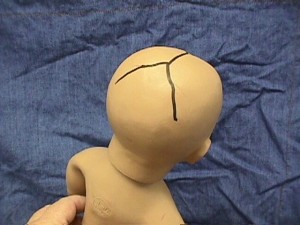
The occiput of the baby has a similar obstetric landmark, the “posterior fontanel.”
This junction of suture lines in a Y shape that is very different from the anterior fontanel.
In cases of fetal scalp swelling or significant molding, these landmarks may become obscured, but in most cases, they can identify the fetal head position as it is engaged in the birth canal.
Occiput Anterior (OA)
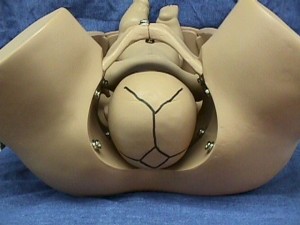
Occiput anterior is usually the easiest position for the fetal head to traverse the maternal pelvis.
Shown here is the “direct OA” position. While some fetuses deliver in this position, others deliver slightly rotated clockwise (LOA) or counterclockwise (ROA). Either way, the fetus is still considered to be an an “anterior” position.
Left Occiput Anterior (LOA)
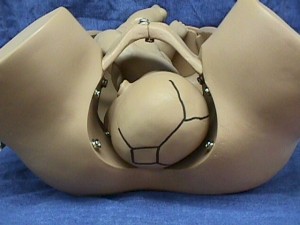
The fetal position is often described using three letters.
This is an example of LOA, meaning:
- Left
- Occiput
- Anterior
In other words, the fetal occiput is directed towards the mother’s left, anterior side.
Right Occiput Anterior (ROA)
ROA means:
- Right
- Occiput
- Anterior
These anterior presentations (ROA and LOA) are normal and usually are the easiest way for the fetus to traverse the birth canal.
Transverse Position
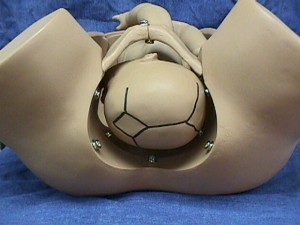
This LOT (Left, Occiput, Transverse) position and its’ mirror image, ROT, are common in early labor.
As labor progresses and the fetal head descends, the occiput usually rotates anteriorly, converting this LOT to an LOA or OA as the head delivers.
If the head fails to rotate despite steady descent, this is called a “deep transverse arrest,” and is common among:
- Babies who are too big to come through, and
- Mothers with flat pelvises that favor a transverse delivery
Women with this condition who fail to deliver spontaneously are treated with cesarean section, forceps, or vacuum extraction, depending on the clinical circumstances, available resources, and experience of the operator.
Occiput Posterior

Occiput posterior positions, including direct OP, LOP (Left Occiput Posterior) and ROP (Right Occiput Posterior) are positions favored by certain internal pelvic shapes. This position has some obstetrical significance.
Normally, if the head is at 0 Station, the biparietal diameter is at the pelvic inlet and the head is fully engaged. In posterior positions, at 0 Station, the biparietal diameter is still a couple centimeters above the pelvic inlet, meaning that the head is not fully engaged.
Babies can deliver in the posterior position, but the pelvis needs to be large enough and it usually takes longer.
Forceps are often used to deliver babies in this position, but there is controversy whether the fetus should be delivered in the posterior position, or rotated with the forceps to the anterior position. Much depends on the clinical circumstances and the experience of the operator.
Breech Positions

The terms used for breech positions are the same as for cephalic positions, except the sacrum of the fetus is used as the identifying landmark, instead of the occiput.
- Sacrum Anterior (SA) means the fetal sacrum is closest to the mother’s symphysis.
- Left Sacrum Anterior (LSA) means the fetal sacrum is closest to the mother’s symphysis and rotated slightly to the mother’s left (clockwise from direct SA).
- Right Sacrum Anterior (RSA) means the fetal sacrum is closest to the mother’s symphysis and rotated slightly to the mother’s right (counterclockwise from direct SA).
- Right Sacrum Transverse (RST)
- Left Sacrum Transverse (LST)
- Right Sacrum Posterior (RSP)
- Left Sacrum Posterior (LSP)
- Sacrum Posterior (SP)
